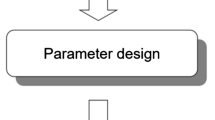Abstract
A method is presented in this paper for coordinating multiple modes of capacity adjustment in work systems with autonomous WIP regulation with the goal of maintaining desired fundamental dynamic behavior. To prevent overcorrection of capacity, adjustments involving floaters, temporary workers, overtime, etc. need to be coordinated, and it is shown that control-theoretic analysis can be used to develop algorithms for determining combinations of adjustments that result in WIP regulation that is as fast-acting as possible yet non-oscillatory. Results of discrete event simulations in Arena, driven by industrial data, are used to illustrate the dynamic behavior of WIP regulation in an autonomous work system that incorporates such an algorithm and multiple modes of capacity adjustment.







Similar content being viewed by others
References
Nyhuis P, Weindahl H-P (2009) Fundamentals of production logistics: theory. Tools and Applications Springer, Berlin
Wild B, Schneeweiss C (1993) Manpower capacity planning—a hierarchical approach. Int J Prod Econ 30–31:95–106
Foote DA, Folta TB (2002) Temporary workers as real options. In: Human resources management review, vol. 12, pp 579–597
Delarue A, Gryp S, Hootegem GV (2006) The quest for a balanced manpower capacity: different flexibiliy strageies examined. In: Enterprise and work innovation studies, vol. 2, pp 69–86
Windt K, Hülsmann M (2007) Changing paradigms in logistics—understanding the shift from conventional control to autonomous cooperation and control. In: Hülsmann M, Windt K (eds) Understanding autonomous cooperation and control in logistics. Springer, Berlin, pp 1–16
Duffie NA, Shi L (2009) Maintaining constant WIP-regulation dynamics in production networks with autonomous work systems. CIRP Annal Manuf Technol 58(1):399–402
Duffie N, Shi L (2010) Dynamics of WIP regulation in large production networks of autonomous work systems. IEEE Transact Autom Sci Eng 7(3):665–670
Toshniwal V, Duffie N, Jagalski T, Rekersbrink H, Scholz-Reiter B (2011) Assessment of fidelity of control-theoretic models of WIP regulation in networks of autonomous work systems. CIRP Annal Manuf Technol 60(1):485–488
Toshniwal V (2011) Assessment of WIP regulation in networks of autonomous work systems. Madison, M.S. Thesis, University of Wisconsin-Madison
Author information
Authors and Affiliations
Corresponding author
Rights and permissions
About this article
Cite this article
Duffie, N., Fenske, J. & Vadali, M. Coordination of capacity adjustment modes in work systems with autonomous WIP regulation. Logist. Res. 5, 99–104 (2012). https://doi.org/10.1007/s12159-012-0088-7
Received:
Accepted:
Published:
Issue Date:
DOI: https://doi.org/10.1007/s12159-012-0088-7




